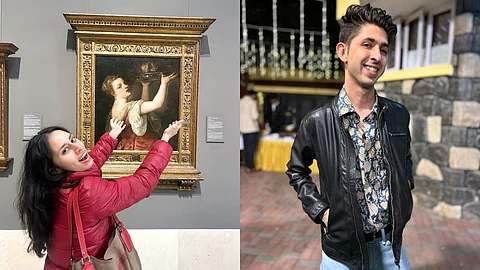
- HOMEGROWN WORLD
- #HGCREATORS
- #HGEXPLORE
- #HGVOICES
- #HGSHOP
- CAREERS
- ABOUT US
- CONTACT US

I know how this sounds. “Boo hoo, poor her, someone said she looks foreign! How ever will she survive this tragic fate?”
I’m aware of how absurd it is to even feel conflicted about something that, in the grand scheme of things, is a mosquito bite. But that’s the thing about identity — it’s messy, layered, and full of contradictions. So, bear with me as I attempt to make sense of my first-world problems.
Growing up, being told I didn’t look “that Indian” felt like the weirdest compliment. The words would come casually, at family gatherings, school corridors, and later, in foreign cities. Initially, I shrugged it off as harmless, even flattering. But as I grew older, I started wondering what these comments really meant — and why they felt so unsettling.
I once dated someone who told me I looked Eastern European, and how much he loved that about me. He confessed, casually, that he’d always fantasised about being with a white girl — and I fed into that. I brushed it off as an awkward compliment, but with time, I saw it for what it was: fetishisation. It was disorienting to feel like my appearance made me both an object of affection and a departure from who I really am.
This dissonance follows me in ways both glaring and subtle. Two weeks ago, during a trip to Amsterdam with my friends, we dressed up, braved the cold, and stood in line waiting to enter a famous club. When we reached the door, the bouncer gave us a long, scrutinising look. Then, with a wave of his hand, he gestured for me to step in. My friends, though? They were turned away without explanation.
European clubs are infamous for their opaque door policies. I didn’t look “that Indian”, so I got a pass. My friends, with their darker skin, did not. This moment was a stark reminder of a larger historical narrative. During the British Raj, Indians were systematically denied access to clubs, schools, and institutions reserved for Europeans. These spaces were meticulously curated to maintain the illusion of white superiority, often under the guise of 'propriety'.
Even after the end of colonial rule, the legacy of these racial barriers persists, albeit in subtler ways. The acceptance of one Indian as an exception while rejecting others is not progress — it's tokenism. It’s a reminder that many 'white' spaces, historically guarded by the colour of skin, still operate under those archaic, exclusionary frameworks.
Being fair-skinned in India is like walking around with a cheat code. It’s stupidly unfair, but it’s a reality I benefit from. There’s guilt, of course. Guilt because I know this opens doors that should never have been shut for others. Guilt because I know I should feel worse about it. And guilt because, sometimes, I don’t. I use it to my advantage when I need to — whether it’s avoiding scrutiny or blending in. There’s a part of me that hates this complicity, but another that’s all too aware of how survival often demands it. Yet, there’s an irony in the privilege. While my light skin sometimes 'elevates' me in societal hierarchies, it also distances me from a part of myself I deeply value. How do you reconcile looking 'not Indian' with knowing that you are?
The whole notion of looking 'Indian' is flawed from the start. India is millions of faces, features, and skin tones. The image of Indian-ness we’re often sold — usually rooted in North Indian ideals — is woefully inadequate. People from the Northeast, with their almond-shaped eyes and sharper cheekbones, are routinely asked, “But where are you really from?” People from the South, with their darker complexions and distinct features, face relentless stereotyping. And yet, these differences are what make us, us.
To claim there’s a singular “Indian” look is to erase our diversity. If you’ve ever taken a walk in Mumbai, you’ll know — we don't fit into a single frame, and neither should our image of 'desi-ness'. We’ve turned appearance into a litmus test for belonging, when belonging is, and should be, far more expansive. In the end, what does it mean to look Indian? Does it mean almond eyes or big round ones, wheatish skin or ebony, straight hair or curls? India doesn’t — and shouldn’t — fit into a single mould.
But that’s the paradox: while our diversity is our strength, our perception of Indian-ness is rigid, binary, and hopelessly narrow. My experience of being told I don’t look Indian has taught me identity is about more than appearance. If we’re going to define Indian-ness, let’s define it in a way that reflects who we really are: a collection of cultures, history, and lived experiences that don’t fit neatly into any box.
If you enjoyed reading this, here's more from Homegrown:
Arpan Mukherjee's Alt Photography Subverts India's Obsession With Fair Skin
Fairness Creams Continue To Amplify Light Skin Supremacy & Anti-Blackness
‘Dark & Lovely’ Is A Powerful Take On Indian Society’s Fair-Skin Obsession
